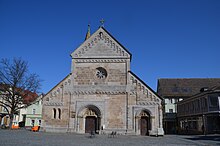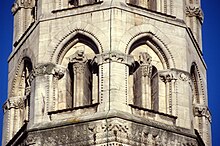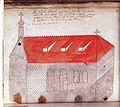Johanniskirche (Schwäbisch Gmünd)
The Johanniskirche or St.-Johannis-Kirche (officially a subsidiary church of St. Johannes Baptist of the Catholic parish church Heilig-Kreuz-Münster ) is a Catholic town church in the Romanesque or neo-Romanesque style in Schwäbisch Gmünd , which is consecrated to John the Baptist . The pillar basilica as a lapidarium for the Gmünder Münster .
The Johanniskirche, which with its outstanding bell tower stands directly at the transition between Johannis- and Marktplatz , is a popular photo motif and landmark of the city of Schwäbisch Gmünd. It is part of some logos, such as for the city anniversary in 2012.
From June 24, 2005 to 2016, the Johanniskirche also served as a church space for the Gmünder Jugendkirche .
Founding saga
Agnes von Hohenstaufen , the daughter of Emperor Heinrich IV and the wife of Duke Friedrich von Staufen , lost her wedding ring while hunting in the Rems Valley. In her desperation, she vowed that she would have a church built on the site of the wedding ring. The ring was found on the site of the later St. John's Church in the antlers of a hunted deer and Agnes von Hohenstaufen had a church built on this site.
Building history
When and by whom the Romanesque St. John's Church was built is not known. There are assumptions that two previous buildings already existed at this point. The first mention of a Johanniskirche in Schwäbisch Gmünd took place in 1225 as part of a miracle story by Caesarius von Heisterbach . Usually the construction time is set in the period from 1210 to 1230.
In the 15th century the Johanniskirche was redesigned. It received elements of the Gothic , above all a two-bay Gothic choir with a 5/8 end was built, the side aisles were raised and Gothic tracery windows were installed on the north, south and west sides. In 1429 the new Gothic high altar was inaugurated.
In 1706 the Johanniskirche was changed again. Among other things, the interior was made Baroque with elaborate stucco work .
The greatest structural change happened in the period of historicism , when the Johanniskirche was re-Romanized under the direction of the architect Hermann Steindorff (1842–1917). Most of the choir was demolished and replaced by a neo-Romanesque choir, the side aisles were made lower again and the windows were restored to their Romanesque shape. The painting of the church was done in 1878/79 by the Rottenburg art and church painter Carl Dehner .
The St. John's Church has been renovated in several stages since 2008. Since the building is a side church of the Heilig-Kreuz-Münster parish, the Münsterbauhütte is in charge of this renovation work.
Bell tower
The construction time of the bell tower is also unknown. It is accepted between 1240 and 1250. At first it was free-standing and is the tallest structure in Schwäbisch Gmünd.
The tower is divided into three sections. The square foundation is followed by long sloping surfaces that transition from a rectangular to a square shape. The end is the two-story, octagonal bell chamber, which is crowned by a pointed helmet. The arches of the sound openings in the bell house reveal early Gothic elements.
From 1959 to 1970 the tower was statically secured and renovated, but the bell tower still has an inclination of almost one meter.
The tower has been open since 2006. It can be climbed from May to October and offers a good view of Schwäbisch Gmünd from the tower room, which is around 30 m high .
Dimensions
The total length is 53 m, the nave is 36 m and the choir 17 m long. The inside width is 25–28 m. The bell tower is 48 m high.
Furnishing
overview
Only a few evidence from the Romanesque period can be found in the interior. The interior is mainly neo-Romanesque. 1870 wall, ceiling and stained glass, high altar, side altar, were Ambone , pews, western gallery and organ created.
The side aisles of the basilica are used by the Münsterbauhütte Schwäbisch Gmünd as a public lapidarium , which means that the sculptures that have been replaced at the cathedral can be made accessible to the public. In the long term, the Münsterbauhütte plans to set up its own lapidarium in the form of a museum with the Münster community on Münsterplatz , as the current solution affects the effect of the church interior of the Johanniskirche.
The pews have been removed since 2005 and replaced with seating.
Staufer Madonna
The Romanesque pillar Madonna , also known as the Staufer Madonna , has been in the interior under the choir arch since 1972 . Until then it was attached to the south side of the church, today there is a reproduction there. The Madonna originally comes from the predecessor building of the Gmünder Munster . It is considered to be the most valuable sculpture in the city of Schwäbisch Gmünd and its date of origin is estimated at the end of the 12th century ( Hermann Kissling ). A direct model of this figure of Mary could not yet be proven, but the group Maria with the child is a Nicopoia .
The sculpture was shown in 2010/11 in the exhibition Die Staufer and Italy in the Reiss-Engelhorn-Museums in Mannheim .
organ
The Johanniskirche probably had a small organ in the choir room until 1775 . Her successor was made by Josef Neher, an organ builder in the city. According to Dominikus Debler , it was moved there after the Lutherans took over the Augustinian Church , whose organ fell victim to secularization. He also states that this organ was "a small weak work". During the renovation work from 1869 to 1880, the west side of the nave was given a gallery . A suitable instrument was to be built for this, and the Weigle company prevailed with its offer in 1879. The installed Weigle organ was consecrated at a festive service in mid-1880. This church musical instrument has remained largely unchanged since the 19th century, but woodworms and moisture damaged it. In 1917 the tin prospectus pipes had to be handed in for the manufacture of military equipment for the First World War . At that time, the Walker organ building company was doing the organ overhaul and immediately replaced the missing pipes. The instrument is one of the few surviving mechanically controlled organs from this era of organ building. At the initiative of donors and the Münster organist Stephan Beck , the Münster community had the organ carried out by the Klais organ manufacturer from 2009 to 2012, during which 61 pipes were replaced, among other things. Since the Johanniskirche is no longer used for regular mass celebrations, the organ is mainly used at numerous cultural events, including the European Church Music Festival .
- Disposition
|
|
|
|||||||||||||||||||||||||||||||||||||||||||||
Collective train
- Coupling : II / I, I / P, II / P
St. Veit cemetery chapel
The Johanniskirche was surrounded by a cemetery for a long time . To the north of the church and in the cemetery ( ob Karner ) stood the chapel, first mentioned in 1387 as sant Vit . The chapel had a polygonal choir and was laid out on two floors, with a crypt being suspected below . The founding tradition of a Carolingian cell from the Fulrad period is linked to this chapel . In 1803, the chapel was demolished in the course of secularization to make room for the parade ground of the barracks in the preacher .
In October 1972, short excavations were carried out under the direction of Gmünder high school professor Hans-Wolfgang Bächle . An altar base and next to it remains of a floor as well as the outer walls were exposed. In order to mark the location, the floor plan was then incorporated into the pavement of the northeastern Johannisplatz , but partially built over again with a water playground.
Picture of the St. Vitus Chapel in the Chronicle of Dominikus Debler
literature
- Anton Pfitzer : The Johanniskirche zu Gmünd and Bishop Walther I of Augsburg (1133-1154) . Kohlhammer, Stuttgart 1889 ( digitized version ).
- Walter Klein : The St. Johannes Church in Gmünd , Gmünder Art Volume 6, Verlag HL Brönner, Frankfurt am Main 1928.
- Albert Deibele : The Johanniskirche in Schwäbisch Gmünd , Tourist Office Schwäbisch Gmünd, Remsdruckerei, Schwäbisch Gmünd 1957.
- Hermann Kissling : The Baroqueization of the Gmünder Johanniskirche 1706/07. With comments on the periodization of Gmünder baroque art . In: Gmünder Studies 4. Contributions to the history of the city . Schwäbisch Gmünd 1993, ISSN 0170-6756, pp. 43-50.
- Richard Strobel, State Monuments Office Baden-Württemberg: The art monuments of the city of Schwäbisch Gmünd . Volume 2, churches in the old town without the Holy Cross Cathedral; Deutscher Kunstverlag, Munich 1995; ISBN 3-422-00569-2 .
- Richard Strobel: The Johanniskirche in Schwäbisch Gmünd. Staufer monument and "luxury building" from 1870 . Gmünder Geschichtsverein, Schwäbisch Gmünd 1997, ISBN 3-00-002206-6 .
- Johannes Schüle: The historical organ of the Johanniskirche , in Einhorn Jahrbuch Schwäbisch Gmünd 2006, Einhornverlag Schwäbisch Gmünd 2006, ISBN 978-3-936373-29-5 ; Pp. 145-150.
- Peter Spranger et al., Münsterbauverein Schwäbisch Gmünd (ed.): St. Johanniskirche in Schwäbisch Gmünd . Fischerdruck, Herlikofen 2006.
- Hubert Herkommer : Enthroned Maria with child, so-called Staufer Madonna , in Alfried Wieczorek et al. (Ed.): Die Staufer and Italy , Volume 2 Objects, Curt Engelhorn Foundation and Scientific Book Society, Darmstadt, Mannheim 2010, ISBN 978-3-534-22834-8 ; P. 236.
- Stephan Beck : On the restoration of the Carl Gottlob Weigle organ in the St. Johanniskirche Schwäbisch Gmünd , in Einhorn Jahrbuch Schwäbisch Gmünd 2012, Einhornverlag Schwäbisch Gmünd 2012, ISBN 978-3-936373-84-4 ; Pp. 109-112.
Web links
- Johanniskirche on the website of the Münsterbauverein eV Schwäbisch Gmünd
- Klaus Graf : Der Ring der Herzogin , 1987 ( online ) on the founding saga with hypotheses on the original function of the church; see also The Gmünder Ringsage. Origin and development of a Staufer tradition ( online ).
- City information about the Johanniskirche
Individual evidence
- ^ Johanniskirche> tower on the website of the Münsterbauverein eV Schwäbisch Gmünd
- ↑ Schwäbisch Gmünd 2012 on stauferstelen.net. Retrieved March 23, 2014.
- ↑ http://remszeitung.de/2011/8/11/unbekannte-goennerin-spendet-sechsstellige-summe-fuer-die-renovierung-der-johanniskirchen-orgel/
- ^ Strobel: Die Kunstdenkmäler der Stadt , Volume II, pp. 262–265.
- ^ Rems-Zeitung of October 12, 1972, p. 9.
Coordinates: 48 ° 47 ′ 59.5 " N , 9 ° 47 ′ 49" E












